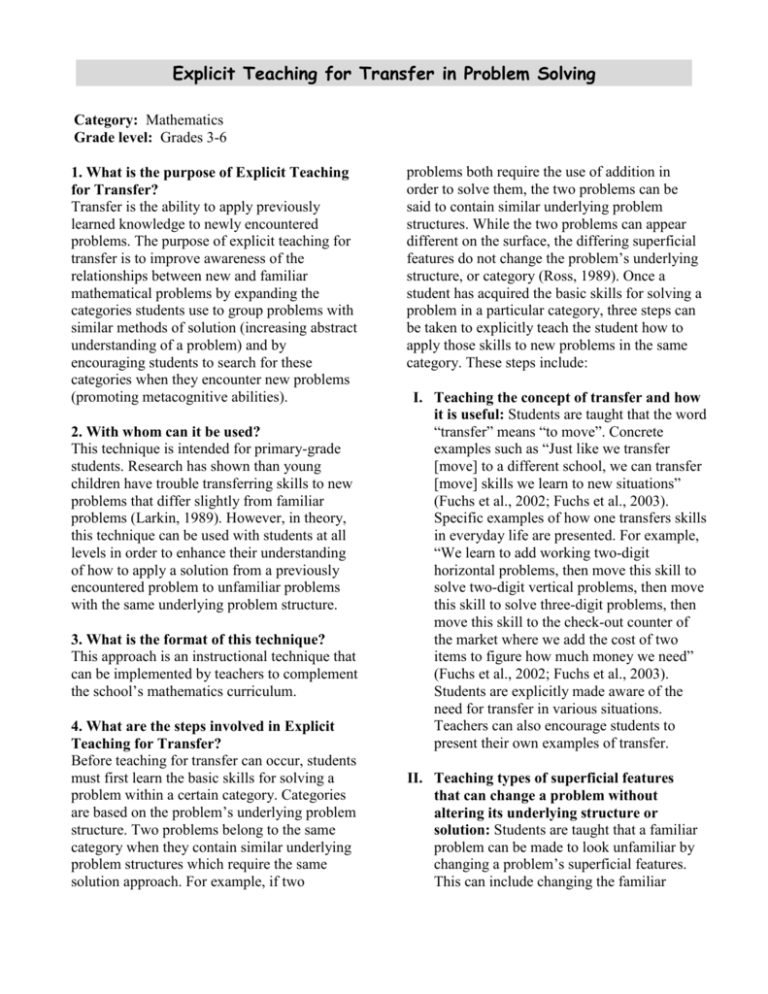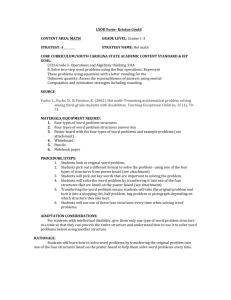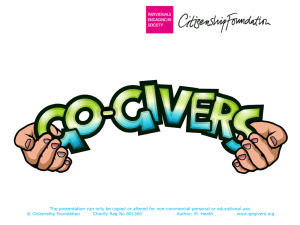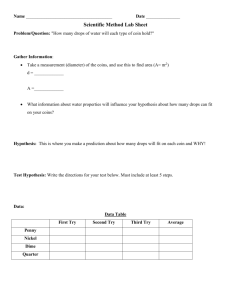Mapping Instruction
advertisement

Explicit Teaching for Transfer in Problem Solving Category: Mathematics Grade level: Grades 3-6 1. What is the purpose of Explicit Teaching for Transfer? Transfer is the ability to apply previously learned knowledge to newly encountered problems. The purpose of explicit teaching for transfer is to improve awareness of the relationships between new and familiar mathematical problems by expanding the categories students use to group problems with similar methods of solution (increasing abstract understanding of a problem) and by encouraging students to search for these categories when they encounter new problems (promoting metacognitive abilities). 2. With whom can it be used? This technique is intended for primary-grade students. Research has shown than young children have trouble transferring skills to new problems that differ slightly from familiar problems (Larkin, 1989). However, in theory, this technique can be used with students at all levels in order to enhance their understanding of how to apply a solution from a previously encountered problem to unfamiliar problems with the same underlying problem structure. 3. What is the format of this technique? This approach is an instructional technique that can be implemented by teachers to complement the school’s mathematics curriculum. 4. What are the steps involved in Explicit Teaching for Transfer? Before teaching for transfer can occur, students must first learn the basic skills for solving a problem within a certain category. Categories are based on the problem’s underlying problem structure. Two problems belong to the same category when they contain similar underlying problem structures which require the same solution approach. For example, if two problems both require the use of addition in order to solve them, the two problems can be said to contain similar underlying problem structures. While the two problems can appear different on the surface, the differing superficial features do not change the problem’s underlying structure, or category (Ross, 1989). Once a student has acquired the basic skills for solving a problem in a particular category, three steps can be taken to explicitly teach the student how to apply those skills to new problems in the same category. These steps include: I. Teaching the concept of transfer and how it is useful: Students are taught that the word “transfer” means “to move”. Concrete examples such as “Just like we transfer [move] to a different school, we can transfer [move] skills we learn to new situations” (Fuchs et al., 2002; Fuchs et al., 2003). Specific examples of how one transfers skills in everyday life are presented. For example, “We learn to add working two-digit horizontal problems, then move this skill to solve two-digit vertical problems, then move this skill to solve three-digit problems, then move this skill to the check-out counter of the market where we add the cost of two items to figure how much money we need” (Fuchs et al., 2002; Fuchs et al., 2003). Students are explicitly made aware of the need for transfer in various situations. Teachers can also encourage students to present their own examples of transfer. II. Teaching types of superficial features that can change a problem without altering its underlying structure or solution: Students are taught that a familiar problem can be made to look unfamiliar by changing a problem’s superficial features. This can include changing the familiar problem’s format or key words, adding questions to the familiar problem, or placing the familiar problem within a larger problem-solving context (see Figure 1 for examples of these changes). A poster illustrating the ways in which problems can change can be used to facilitate teaching. Students should be given a familiar problem along with variations of the familiar problem which contain superficial feature changes. Students are asked to identify which superficial feature changes are in each new problem and should explain how each new problem appears different, yet maintains the same underlying structure as the familiar problem. Students should be asked to apply a solution method learned for a familiar problem to the same problems with differing superficial features. Students are grouped into smaller groups or pairs when practicing how to apply familiar solutions to superficially changed problems. Practice can begin with partially worked examples and students should check their work using answer keys. Stronger students can be paired with weaker students in order to facilitate learning. Eventually, students should be encouraged to work on problems independently. III. Encouraging the search for familiar problem structures in unfamiliarlooking problems: Teachers should encourage students to search for superficial changes in unfamiliar problems in order to recognize familiar problem structures and apply previously learned solutions. 5. In what types of settings is Explicit Teaching for Transfer useful? Research has shown that explicit teaching for transfer can be effective when conducted by teachers with large groups in classroom settings. 6. To what extent has research shown Explicit Teaching for Transfer to be useful? The effectiveness of this technique has been demonstrated with third-grade students, including some with learning disabilities (Fuchs et al., 2003). Explicit teaching for transfer improved the ability of these students to solve both near-transfer problems (problems that differ from the original problem in terms of cover stories and one superficial feature) and fartransfer problems (problems embedded in a reallife problem-solving context that differ from the original problem in terms of four superficial features, as well as the addition of irrelevant information) when compared to control groups. The effects of explicit teaching for transfer are enhanced when children are given longer initial instructional sessions in rules for problem solution. Similar findings have been suggested with fourth-grade students (Fuchs et al., 2002). More research with other age groups is required. References 1. Cooper, G., & Sweller, J. (1987). Effects of schema acquisition and rule automation on mathematical problem-solving transfer. Journal of Educational Psychology, 79, 347-362. 2. Fuchs, L.S., Fuchs, D., Hamlett, C.L., & Appleton, A.C. (2002). Explicitly teaching for transfer: Effects on mathematical problemsolving performance of students with mathematics disabilities. Learning Disabilities Research and Practice, 17, 90-106. 3. Fuchs, L.S., Fuchs, D., Prentice, K., Burch, M., Hamlett, C.L., Owen, R., Hosp, M., & Jancek, D. (2003). Explicitly Teaching for Transfer: Effects on Third-Grade Students’ Mathematical Problem Solving. Journal of Educational Psychology, 95(2), 293-305. 4. Larkin, J.H. (1989). What kind of knowledge transfers? In L.B. Renick (Ed.), Knowing, learning, and instruction (pp. 283-305). Hillsdale, NJ: Erlbaum. 5. Ross, B.H. (1989). Distinguishing types of superficial similarities: Different effects on the access and use of earlier problems. Journal of Experimental Psychology: Learning, Memory, and Cognition, 15, 456-468. 6. Salomon, G., & Perkins, D.N. (1989). Rocky roads to transfer: Rethinking mechanisms of a neglected phenomenon. Educational Psychologist, 24, 113-142. Reviewed by: Carly Guberman Figure 1. EXAMPLES OF SUPERFICIAL PROBLEM FEATURE CHANGES MADE TO AN ORIGINAL PROBLEM (Fuchs et al., 2002; Fuchs et al., 2003) Original Problem You want to buy some lemon drops. Lemon drops come in bags with 10 lemon drops in each bag. How many bags should you buy to get 32 lemon drops? 1) Superficial Feature Change: Different Format You want to buy some lemon drops. The sign at the store looked like this: How many bags should you buy to get 32 lemon drops? ○ ○ ○ ○ 3 4 2 5 2) Superficial Feature Change: Different Key Word You want to buy some lemon drops. Lemon drops come in packages with 10 lemon drops in each package. How many packages should you buy to get 32 lemon drops? 3) Superficial Feature Change: Additional Questions You want to buy some lemon drops. Lemon drops come in bags with 10 lemon drops in each bag. How many bags should you buy to get 32 lemon drops? If each bag costs $4, how much money will you spend? 4) Superficial Feature Change: Placing Familiar Problem Within Larger Problem-Solving Context You saved $37. Your friend saved $12. You and your friend want to buy some lemon drops. Lemon drops come in bags with 10 lemon drops in each bag. You want 32 lemon drops. 1. How much money do you and your friend have? 2. If each bag of lemon drops costs $4, how much money will you spend on lemon drops? 3. If you also buy a hat that costs $15, how much money will you have left?






